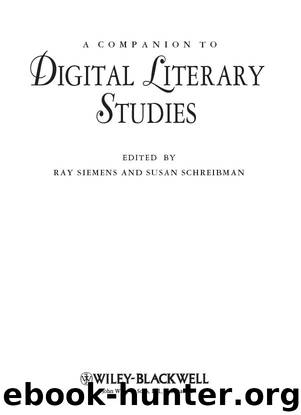A Companion to Digital Literary Studies by Siemens Ray; Schreibman Susan; & Susan Schreibman

Author:Siemens, Ray; Schreibman, Susan; & Susan Schreibman
Language: eng
Format: epub
Tags: Digital Literary Studies
Publisher: Wiley
Published: 2013-03-17T16:00:00+00:00
16
Private Public Reading: Readers in Digital Literature Installation
Mark Leahy
Introduction
This chapter sets the genre of installed digital literature in the context of other disciplines and art forms. It uses an intersection of critical frames from the visual arts, cinema, and writing to develop a way of thinking about a body of work that uses text, digital media, and space or location as integral features. The topic being at an intersection of disciplines, and so not neatly interpretable with the tools used for any particular one, the chapter addresses a number of aspects of these overlapping disciplines to venture a means of understanding how we read installed digital literature.
In an interview with Roberto Simanowski, digital artist Noah Wardrip-Fruin discusses the role of text in his own work and in the work of certain other artists who create digital installations. Simanowski comments on Wardrip-Fruin’s work: “it strikes me that your works are installations, or performances, in which text is not reduced to ‘graphical objects’ as you put it, stripped of linguistic function” (Wardrip-Fruin 2005a). The textual elements in these works are there to be read. Referring to a work by Camille Utterback and Romy Achituv (Utterback 1999), Wardrip-Fruin comments:
I think for Camille and Romy the particular text that’s in Text Rain is important. They used lines of a poem, and negotiated for the copyright clearance. They wouldn’t have done that if it didn’t matter what text they used. (ibid.)
He is making a distinction between the use of words or text or writing, of literature within digital work, where what the words say or mean or how they are read is significant. They are something to be read, not something to be merely recognized as letters or words or text. If the point of the work Text Rain was to demonstrate the functioning of the interface, the possibility for the audience or users to manipulate the falling letters, then what the words said, how they combined into phrases would matter little. This he feels is the view of the audience from an electronic art background. He goes on to contrast the attitude to the writing, the text in other art or digital works.
People in the prints-on-walls art community don’t think that you could arbitrarily substitute text in a Barbara Kruger piece. People in the electronic writing community don’t think you could arbitrarily substitute text in a John Cayley piece. But text, for some reason, doesn’t seem to be a recognized artistic medium in the electronic art world. (ibid.)
The business of writing and reading, then, is important in the work Wardrip-Fruin makes. And this is a reading and writing that occupies physical space and may be carried out in the company of other readers. This is literature that shares features of other disciplines or other modes of writing or of making art.
The perception of a genre of installed digital literature is a result of the shifting of the gaze of the writer’s/critic’s attention that is focused on distinct discrete events drawn together as a grouping by the act of observation/attention.
Download
This site does not store any files on its server. We only index and link to content provided by other sites. Please contact the content providers to delete copyright contents if any and email us, we'll remove relevant links or contents immediately.
Algorithms of the Intelligent Web by Haralambos Marmanis;Dmitry Babenko(8322)
Azure Data and AI Architect Handbook by Olivier Mertens & Breght Van Baelen(6931)
Building Statistical Models in Python by Huy Hoang Nguyen & Paul N Adams & Stuart J Miller(6916)
Serverless Machine Learning with Amazon Redshift ML by Debu Panda & Phil Bates & Bhanu Pittampally & Sumeet Joshi(6793)
Data Wrangling on AWS by Navnit Shukla | Sankar M | Sam Palani(6583)
Driving Data Quality with Data Contracts by Andrew Jones(6541)
Machine Learning Model Serving Patterns and Best Practices by Md Johirul Islam(6273)
Learning SQL by Alan Beaulieu(6018)
Weapons of Math Destruction by Cathy O'Neil(5809)
Big Data Analysis with Python by Ivan Marin(5468)
Data Engineering with dbt by Roberto Zagni(4467)
Solidity Programming Essentials by Ritesh Modi(4117)
Time Series Analysis with Python Cookbook by Tarek A. Atwan(3981)
Pandas Cookbook by Theodore Petrou(3686)
Blockchain Basics by Daniel Drescher(3318)
Hands-On Machine Learning for Algorithmic Trading by Stefan Jansen(2921)
Feature Store for Machine Learning by Jayanth Kumar M J(2829)
Learn T-SQL Querying by Pam Lahoud & Pedro Lopes(2813)
Mastering Python for Finance by Unknown(2755)
